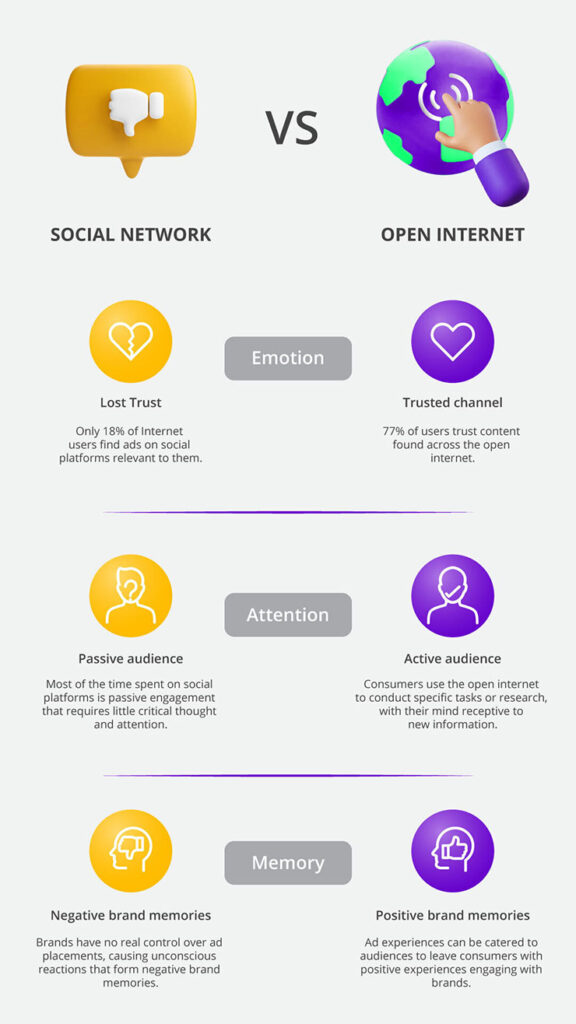Understanding Your Customer’s Brain on Advertising

Have you considered the mindset of your advertising audience? How do consumers think about engagement across the internet and what inspires them to make specific decisions? Consumer behavior data and artificial intelligence are being combined to improve the advertising experience for consumers and campaign performance for advertisers.
The Average Consumer
Our real-time mindset dramatically impacts our decisions. The content we engage with, the content we share and the purchases we make are all informed by our current state of mind.
Brands & Advertisers
It is our mission to connect with as many new audiences as possible and inspire them to engage. The content that we create for this purpose must be designed and deployed in a way that appeals to the right people at their most receptive moments.
Focusing on the Brain
Advancements in technology allow us to unlock new information on the brain of advertising audiences, and deploy campaigns that improve experience and increase engagement with your brand. With the right tools, businesses of all sizes can run intelligent campaigns across the open internet that appeal to audiences in a personalized manner by leaning on learnings found in neuromarketing research.
So pour yourself a drink, and get ready to dig into your customer’s brain on advertising.
What is Neuromarketing?
“Neuromarketing” is a relatively new term that was coined by renowned Harvard Business School Professor, Gerald Zaltman, in 2002. Zaltman’s experiments in the 1990’s around the human subconscious and emotional response to images paved the way for advertising strategy at hundreds of major companies including Coca-Cola, General Motors, Nestle and beyond.
Today, neuromarketing has become known as a field of commercial marketing that studies consumer cognitive, sensorimotor and affective response (AR) to marketing stimuli. While research and strategy in this area has changed over the last 20 years, so has technology. The current state of data and online engagement habits is allowing brands to improve communication with consumers on both a conscious and unconscious level.
Thanks to neuroscience, we can pinpoint precise reactions to advertising content that prompt emotional responses, activate memories and draw attention. Artificial intelligence and machine learning allow us to use this neuroscience data to determine exact elements that make an ad effective in order to deepen impact and boost ROI.
Neuromarketing Tools
Collecting and measuring neuromarketing data requires a few common tools to scan the brain, assess neural activity, track physiological patterns and measure eye movement.
fMRI: Functional magnetic resonance imaging uses powerful magnetic fields to track the brain for changes in blood flow over time.
EEG: Electroencephalogram uses sensors to read brain-cell activity and track changes over fractions of a second.
Eye Tracking – Gaze: Used to detect where an individual focuses their gaze in order to
determine what catches their attention and what confuses them.
Eye Tracking – Pupillometry: Used to measure the dilation of an individual’s pupils and track engagement levels.
Biometrics: Used to measure respiration, heart rate and skin conductance and gauge positivity or negativity of response to stimuli.
Facial Coding: Examines facial expression to gauge emotional responses such as surprise, fear and happiness.
Historic Neuromarketing Findings
All of the tools outlined above make it possible to unlock valuable lessons on consumer engagement. Researchers have found that engaging content triggers similar responses across most individuals, creating a signature that can identify a successful ad. These signatures can be broken down into four primary categories:
- Emotional: Ad creates positive emotional associations
- Attention: Ad uses captivating branding to stimulate the brain
- Memory: Ad inspires attention and recall of information, shaping and sustaining memories
- Valuation: Ad clarifies the cost vs. benefit analysis at the core of decision making
A few select studies standout as important moments in the field of neuromarketing.
2004 Baylor College of Medicine
Reprising the classic “Pepsi Challenge” campaign, researchers were able to show how positive brand memories around brand recognition influence consumer choices. Participants were served cups in a number of combinations, with the cup presumed to be Coke coming out the overwhelming winner, despite Pepsi winning when cups were unmarked.
2008 University of California
Scientists conducted a study on computer-savvy adults, exploring how actively searching the open internet triggers parts of the brain that control decision making and complex reasoning. The findings of the study suggested that searching the open internet stimulates and potentially improves brand function.
2014 Facebook Study
Facebook conducted a study in 2014 in which they manipulated content flowing through users’ feeds in order to better understand how social media impacted mood. The result was rather expected, as the users’ mood reflected the emotional state of the content that they were being served. A related study conducted earlier in the year found that frequent social media users were nearly 3 times more likely to be depressed.
2019 Harris et al.
Research was conducted in an attempt to improve the efficacy of ads related to social causes and public health. The results demonstrated that action/emotion-based marketing that inspired audiences to act, share, promise or challenge were more effective than more rational ads. Another interesting finding here was that no attention peaks were produced when brand logos were being viewed.

The Future of Neuromarketing
Having expanded in scope since the term was coined, neuromarketing is continuing to advance thanks to emerging technologies. Artificial intelligence is becoming a great tool to further this advancement due to the ability to sort billions of data points and illuminate patterns. As digital consumers, data is left in the wake of our online path from social media to e-commerce sites to platform memberships and online services we’ve signed up for.
We are in a prime position to improve the marketing experience for advertisers and consumers. Advertising experiences will become more personalized and enjoyable, tailoring the path to purchase for receptive and happy audiences. Brands will have new ways of serving content to accurately matched audiences, increasing engagement and conversions.
Ads will become useful, instead of the nuisance that they are now. Approximately 79% of consumers are bothered by the number of ads displayed to them across platforms, while 44% of users find these ads irrelevant to their wants and needs.
Brands will be able to tap into the open internet as a data source, pulling information from billions of pages and applying AI data models that improve internet experience. Real-time, dynamic ads are being fueled by AI to target the right time and right audience based on special, contextual and predictive data patterns from over 400 billion sites across the open internet.
Solutions now exist to map the open internet so that brands can strategically deploy advertising there.
This all comes at a time when cookies and tracking are going away, and privacy is rightfully being prioritized for internet users across the globe. We are entering an age in which users have more control over their data, including who has access to it and how it is being used. Naturally, the mindset of users online is different than ever before, and brands are noticing proven trends that inform their approach to advertising.
The Social Media Mindset
For many internet users, the instinctual engagement happens on our favorite social media platforms. We unconsciously take out our phones to scroll Instagram, Twitter or TikTok and get that dopamine hit, consistently allowing us to detach from our surroundings for the moment and enter a limitless digital world.
The addictive nature of these platforms has us spending hours of our day opening them up and passing time, but still we don’t trust them. Most of the time spent there is passive engagement that requires little critical thought, as content is served to us on a silver platter that uses neuromarketing to inspire engagement at any cost.
As paid content increases across social media platforms, it becomes harder and harder to cut through the noise. Couple this influx of new content with the less than ideal mindset of the average social media user, and you start to understand why ad campaigns in these walled gardens are consistently falling short.
Lost Trust
We have begun to lose trust in our social media platforms. Big tech platforms have repeatedly been exposed for privacy overreach, providing little transparency on their data collection and usage methods. A rare point of agreement for global citizens of all ages, trust of social media services is at an all time low. Many find the advertising experience on these platforms to be invasive and annoying.
Only 20% of facebook users and 48% of google users truly trust their respective platform to responsibly handle the information collected on internet activity. Brands are reckoning with this, as ad campaigns in these walled gardens continue to underperform. All of the signs point to a skeptical audience that is being served content by algorithms that prioritize based on what will engage users.
Negative Brand Memories
As explored above, the content that boosts engagement is often sad or controversial. Naturally, this results in platforms serving ads in between content that has been curated to make you get emotional and engage. Brands have no real control over the types of content that their ads are served amongst, causing unconscious reactions that form lasting negative brand memories.
Passive Audiences
Nearly 50% of facebook users are scrolling mindlessly, just riding the wave of engagement with whatever content served up. When looking to discover new products or services, only 33% of internet users turn to social media platforms. The intention to act is not clear, and shocking a user out of the passive state of mind requires a level of strategic precision that few advertisers are capable of.
Manipulated by Algorithms
Every piece of content and advertisement is served based on calculations carried out by algorithms. Algorithms monitor our behavior and engagement within a platform in order to cater the experience to our interests and keep us active within the walled garden for as long as possible. For no fault of their own, algorithms are empowered by the desire to boost engagement and this prioritizes certain content.
A result of this is a laundry list of challenges related to breaking through the algorithm and appealing to new audiences in new ways. Users and advertisers are at the mercy of these algorithms, with no control over how content is prioritized or consumed. We must have faith in platforms like facebook and Google to act neutrally and not limit or increase visibility based on preferential treatment and internal politics.

The Open Internet Mindset
The term “Open Internet” might still be new to many marketers, but it is quickly becoming a defining factor in advertising strategies across industries. The term refers to a fundamental network and a concept of neutrality that’s applied to ensure services are free from biases that could slow or block sites in order to favor certain participants.
Most of us use the open internet every day. We navigate the web, moving from platform to e-commerce site to industry blog with ease. Specific tasks and focused intent bring us to the open internet, as we seek knowledge, products and services with a more defined goal than on social media. Our state of mind as consumers on the open internet is much different than on social media, and advertisers should be paying attention.
Trusted Channels
We detailed the lack of trust that users have for social media, but the open internet is not held in such contempt. 77% of users trust articles found across the open internet more than on social media. Similarly, 40% of people say that ads on the open internet are most relevant, while only 18% of people find facebook ads relevant.
Most people stick to their habits, and as internet users our habits can be seen in the sites we visit regularly and the places that we often engage. Everyone has their interests, whether personal or professional and over time we fall into patterns in which we feel comfortable engaging with sites and platforms that deepen our connection to these interests. Industry sites, aggregates, community platforms, content hubs, mobile apps and social feeds all exist within our most commonly visited and most trusted sites.
Brands that can tap into these trusted channels in a way that aligns with the audience can generate valuable engagement over time and leave consumers with memorable touchpoints without the limitations of specific walled garden platforms.
Positive Brand Memories
The mindset and perspective of social media users is passive, manipulated and difficult to engage, making it difficult to leave positive brand memories. Mindset on the open internet is much different, and with the help of AI ad experiences can be catered to audiences in order to leave consumers with positive experiences engaging with your brand.
As technology starts empowering users to own their data and control access, brands can deploy privacy-first campaigns aligned with user interest from the start. This helps ensure that each touchpoint across the open internet is impactful, fueling positive brand recognition into the future.
Active Audiences
Consumers use the open internet to conduct specific tasks. Whether it be to learn more about industry specific solutions or seek out the best appliance for a new kitchen renovation. There is intent behind the actions being conducted, and a level of focus that makes the mind receptive to new information. 61% of people’s time is spent traversing the open internet, which means there is significant opportunity in strategically advertising to these individuals.
Free from Walled Gardens
Consumers don’t restrict themselves to single social media platforms, they tend to naturally seek out all of the platforms, sites and apps that add value. Brands should be similarly free from the restrictions of siloed platforms, and empowered to run borderless campaigns that inspire engagement across the entire open internet.
Want to see how we make neuromarketing a part of your successful online advertising strategy?
CONCLUSION
Advertising strategies are regularly advancing. New platforms and solutions are emerging on a weekly basis, and businesses are left to wrestle with their options and choose what’s best for them and their audience. Neuromarketing has arisen as a way to learn about consumer habits and preferences, and cater your campaigns to the mindset of your audience.
As we gain more insight into the minds of everyday consumers, it’s becoming clear that allocating significant portions of ad spend on social media platforms is not the strongest approach. The state of mind of the average social media user is not as receptive to advertising as we previously thought. However, open internet advertising is emerging as an effective solution for brands that are seeking active audiences with a positive and inquisitive state of mind. As soon as you couple this with AI and machine learning technology, it becomes much easier to engage new audiences on their most trusted site at their most receptive moments.
ReverseAds has solved the riddle of the open internet, mapping it so that your brand can traverse it. If you’d like to learn more, contact us.





